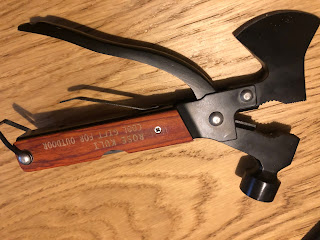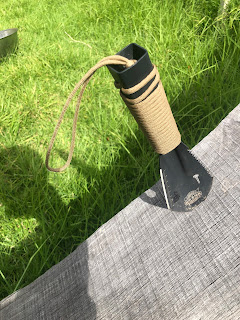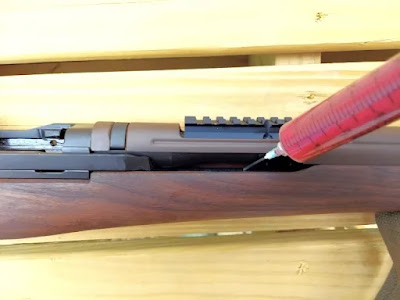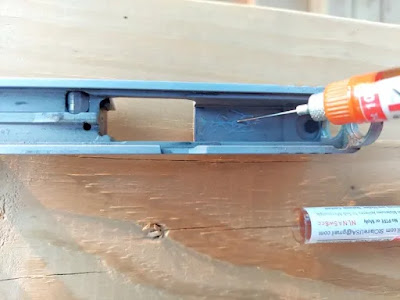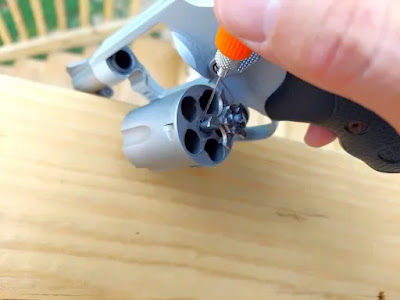Another Guest Author, by way of BB&C, Jim Davis presenting Nano Oil:
Always on the lookout for cool, different ideas, I happened upon a product that caught my eye. Not just for the content of what's in the containers, but the way the containers deliver it to the target. Nano Oil offers some unique and innovative methods of dispensing lubricant onto firearms, knives, and anything else where you want to deposit a controlled amount of oil into a small space.
They have a few various dispensing containers that I'll outline here.
Nano-Oil comes in handy, syringe-like containers. Here is a package with three different weights: 5, 10, and 85 weights.
What Is It And What's It Good For?
First, though, a bit about Nano Oil. It does not contain any of the following: Silicone, PTFE Resins, Graphite, Molybdenum Disulfide know as Moly, Teflon, Copper, Lead, or Silver. They state that there are "absolutely no metals or harmful solvents."
StClair claims that Nano Oil is suitable for high temperature applications, extreme pressure (load bearing metal to metal), roller bearings, chains/sprockets, machine tools, marine equipment, metal working, mining and printing equipment, armaments, knives & multitools, and a ton of other uses. The list is quite expansive.
It works on bicycles, motorcycles, cars, tractors and farm equipment, and RC racers.
Regarding armament, they claim that it increases muzzle velocity and smooths all moving parts while protecting from rust and corrosion. The oil adheres to microscopic crevices and penetrates metals, which provides a very low friction dynamic.
Weights
There are a couple different weights that are offered for various uses.
*5 Weight. This is the lightest weight oil that is offered, noted for deep and fast penetration. They refer to it as "WD-40 on steroids."
*10 Weight. This is a light weight oil that is suitable for guns, flashlight threads, knives, fishing reels, locks, hinges, bicycles, bearings, cables, chains, sprockets, motorcycle forks, electric motor bushings, model railroads, and more. This one seems to be the most useful weight, in general, as it addresses a lot of different uses.
*85 Weight. This is a heavy weight formulation, developed for the M-14/M-1A and other rapid fire firearms.
I ordered and received one each of these weight lubricants in the Micro Oiler with stainless blunt needle, which contains 8cc/ml of oil. These are extraordinarily handy because that needle can get the lube precisely where you want it. Note that the same weight oils can also be had in 1/2 ounce and one ounce bottles.
One of the beautiful aspects of Nano-Oil is the blunt metal applicator tip that allows the user to get the oil where it needs to go. These are the micro oiler containers.
I also received an applicator of Nano-Grease NGL, which is a Lithium Complex Hi Temp & Extreme Pressure lubricant. The uses for it include bearings, boats, buses, cars, bicycles, chains, conveyors, dozers, excavators, graders, laundry equipment, and a bunch of other items. And since the M-1A/M-14 series of weapons are supposed to be lubed with grease, that was my main intention of buying this, as I am using it with my M-1A Scout Squad Rifle.
With the grease syringe, getting into the chamber area of the M-1A Scout Squad Rifle a snap.
Greasing up the operating rod on the M-1A is no longer difficult either.
Nano Oil states that adding its formulations to other existing lubricants will improve their anti-friction qualities.
I have not tried the following, but they are listed on Nano Oil's website:
Gasoline Engine Oil Treatment, Diesel Engine Oil Treatment, Manual Transmission Oil Treatment, 4-Stroke Engine Oil Treatment (Motorcycle, ATV, Snowmobile, Outboard Motors), Small Engine 4-Stroke Oil Treatment, Automatic Transmission Oil Treatment, and Marine Outboard Drive Treatment.
Dispensers
The first is a pen that has something similar to a ball point. The user presses the tip onto the surface where he wants to deposit oil, and the oil comes out. It's fairly controllable too, so you can get a small dot, a larger puddle, or a line. The pen container I received contains 16cc is 10 weight oil, which is listed as "All Purpose." I'd say it would work great for firearms, knives, and anything with moving parts in general. The cap even has a protrusion for hooking onto the user's pocket, so it can be conveniently carried anywhere. The container is white and not see-through. At the time of this writing, one of these pen dispensers costs $27. It appears that it should last quite a while.
The pen is a very handy container to have around!
The tip of the pen is similar to a ballpoint pen, in that when the tip is pressed, it dispenses oil. The user determines how much oil he wants to come out.
The next type is a Micro-Oiler, which is see-through and has a long, blunt, metal needle for getting the lubricant just where you want it. This is especially useful if oiling knives and firearms. Normally, I run my knives dry or nearly so because oils tend to attract dirt and other gunk. The 5 Weight oil will be especially useful for knives because when it dries, it leaves very little residue behind, yet still retains lubricant qualities. This is good stuff!! A 3-pack of these dispensers with 5, 10, and 85 Weight lube, at the time of this writing, costs $49.00. At the rate in which I use lube, I believe these will last me for quite a while.
Finally, the grease dispenser is like a giant syringe that comes complete with a long, blunt metal needle, which gets the grease into those hard-to-reach places. This is especially useful when applying to the M-1A rifle, as it allows the user to get the grease into the areas where the bolt rides in the receiver. Those little grooves can be a pain to reach by other means, but with this setup, it becomes very easy. At the time of this writing, this one costs $21.75.
The grease syringe has a large volume and the metal tip is perfect for getting the grease where you need it to go!
Does It Work?
Naturally, I went totally overboard trying Nano-Oil out on most of my firearms. Those that know me will not be surprised, as I tend to go all-in on my endeavors.
So far, I've used Nano-Oil on my S&W CSX 9mm, S&W Airweight .38 Special Revolver, Glock 43X, Ruger MK IV .22 Long Rifle pistol, Two AR-15s, an AK-47 (AK-63D) Underfolder, and my M-1A Scout Squad Rifle from Springfield Armory. I plan to use it on my bolt action rifles and my Henry Arms Survival Rifle (AR-7). In other words, I will use this stuff on all my firearms and knives.
This AR pistol by Xtreme Gun Worx (of Emmaus PA) and the AK-63D Underfolder benefitted from an application of Nano-Oil.
The pistols that I tried Nano-Oil on, from top to bottom: Ruger MK IV .22LR, Glock 43X, S&W CSX, S&W Airweight 642 .38 Special revolver. They all said they liked Nano-Oil!
Speaking of knives, I've used it on my Emerson Knives Desert Roadhouse. Some of my Spyderco folders will also see Nano-Oil. The nice thing about the 5-weight oil is that it dries up and doesn't leave a gunky residue on knives, but the lubricating benefits still remain.
Getting oil into specific points of a knife action is now easy! Here we see the Emerson Desert Roadhouse getting some care.
I can honestly say that Nano-Oil is good stuff; my firearms' actions were nice and smooth after using it on them. So the quality of the oil and grease itself is sound. Beyond that, what I really found refreshing is the applicators that come with the oil. These really made all the difference when I used them to apply the oil, and they made the job so much easier on most of the guns.
Glock 43X frame rails getting a dose of Nano-Oil. Nano Oil is an obvious choice for gun care, but works well on a variety of other things as well - particularly knives and tools. And don't forget the inside of the slide where parts create friction.
Those hard-to-reach places that used to be a pain to get oil into now are easy to reach, so I expect this will improve the reliability and longevity of my firearms.
The cylinder of the S&W 642 getting some lube.
The Ruger MK IV bolt being coated with 10-weight Nano-Oil. Getting oil inside the receiver is now easy as well.
A special mention here goes out to the Nano-Grease. Applying it to my M-1A Scout Squad rifle is so much easier than trying to get grease into the area where the bolt goes than using a Q-tip. The metal syringe tip placed the grease precisely where I needed it, not only for the channel where the bolt goes inside the chamber and on the receiver, but also onto the operating rod. Kudos to Nano-Oil!
The M-1A Scout Squad Rifle from Springfield Armory is basking in the glory of being freshly lubricated by Nano-Oil.
The Ruger 10/22 will function smoothly with Nano-Oil applied. This is the compact model.
As well, applying it to knives also becomes a breeze, getting the oil in those hard-to-reach places without saturating the entire action of the knife in oil. The user has good control over how much oil comes out of the needles.
All in all, Nano-Oil has a successful product that really delivers (no pun intended). The price is not too high for what the user gets, and the supply should last quite a few cleaning and lubes for one's firearms. This is a great product that I wholeheartedly endorse.
About the Author:
Jim Davis served in the PA Dept. of Corrections for 16 ½ years as a corrections officer in the State Correctional Institute at Graterford and later at SCI Phoenix. He served on the Corrections Emergency Response Team (CERT), several of those years as a sniper, and also the Fire Emergency Response Team (FERT). For 25 years, he was a professional instructor, teaching topics including Defensive Tactics, Riot Control and Tactical Operations, Immediate Responder, and cognitive programs as an adjunct instructor at the DOC Training Academy. He was then promoted to the title of corrections counselor, where he ran a caseload and facilitated cognitive therapy classes to inmates. His total service time was close to 29 years. He was involved in many violent encounters on duty, including incidents of fatalities.

